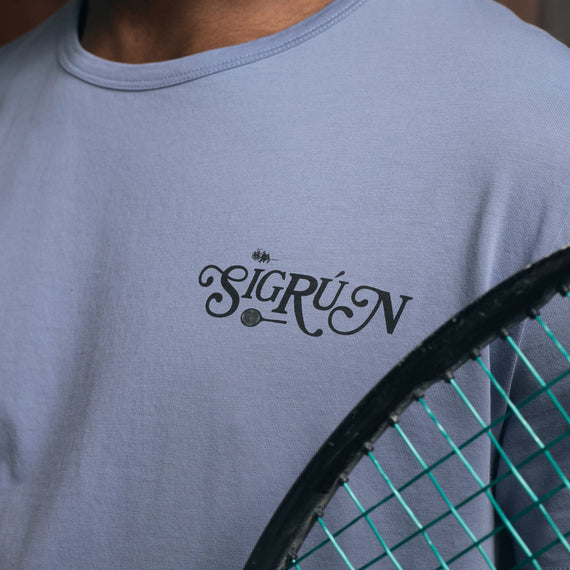Play tennis more sustainably
According to figures from the International Tennis Federation, approximately 87 million tennis players take to the courts each year to chase the fuzzy yellow ball. Whether you are an elite player, a weekend warrior, a 5.5 or a 2.0, we all want to follow our tennis muse in the most sustainable way possible. That means limiting our carbon footprint by playing responsibly, in order to preserve our planet for future generations of tennis players.
Do you want to be a part of the problem, or part of the solution? Easy choice…
Sustainability, and caring for the environment, is no longer a fringe thought. On the professional tour we see household names stepping up and championing environmental awareness. Dominic Thiem, two-time Roland-Garros finalist, surely has some sway when he says: “All players, young and old, have realized this (that tennis isn’t an eco-friendly sport) and want things to change. It's a really good cause. It's one of the biggest problems nowadays that we face, with all the plastic pollution. I love nature and I'm trying to support this whenever I can.”
Part of his post-match celebration is dedicated to his favorite cause: He frequently signs the camera “Play for the oceans.”
Former Wimbledon finalist Kevin Anderson is passionate about the environment as well. “Once your eyes are opened to the plastic pollution problem, it’s hard not to care about the consequences,” he says. “I hope that tennis players can be leaders in this space to raise awareness and help make the public more mindful of reducing single-use plastics when possible.”
We also see tennis retailers, both large and small, gearing their businesses towards sustainability. Tennis ball recycling, recycled gear and apparel, worldwide marketing campaigns all reflect a growing sense of awareness and concern for the environment, sending the message that now—more than ever—is the time to “Go green or go home.”

Tips to be more sustainable as a tennis player
A little effort can go a long way, especially if we all embark on this journey collectively. As passionate tennis players, we’ll have opportunities to make a difference almost every day. There are many simple changes we can make to our daily routines. Everything we use—balls, grips, strings, racquets, clothing, footwear—comes with its own impact. It’s on us to think creatively about how we can reduce our footprint as we play.
Here are some ways we can achieve that collective goal:
Recycling tennis balls and cans
Every year over 300 million tennis balls are discarded around the globe and only a small fraction are actually recycled. How can we reduce the impact of our need for new balls? Recycling specialists like reBounces offer solutions to consumers and Wilson offers a more sustainable tennis ball option.
Additionally, you can recycle balls yourself, or see if your local club can reuse them. Also, encouraging your local club to recycle tennis balls, cans and water bottles (and to also have separate bins for plastic and trash) is a good alternative. Non-profits and services that recycle tennis balls include Tennis Ball Recycling, Project Green Ball and Recycle Balls. The more demand for it, the more we’ll see it happen.

Reduce other “single-use” tennis waste
We tend to generate a decent amount of waste playing tennis, whether it’s your tennis balls and cans (see above), plastic single use water bottles, strings, grips, etc. Reducing your waste of these single-use items can reduce your impact on the environment.
- Use reusable water bottles and if you can’t, ask yourself “why can’t I?” If you absolutely can’t, recycle your plastic bottles.
- Recycle your used strings. Ask your racket stringer what they do with used string and encourage them to recycle used strings (like polyester). Programs like Terracycle can accept used sporting goods equipment including string and overgrips.
- Recycle your overgrips. Many tacky overgrips are made of polyurethane and can be recycled through programs like Terracycle’s mentioned above. Also, ask about recycled polyurethane grips from your grip vendor as well to encourage a market for recycled overgrips.

Reusing and repurposing equipment
Hand me downs of gear and clothing to local youth clubs or tennis camps can make a huge difference in your community. And it can help young players get involved in the sport at a lower price point, helping grow the game.
Donating, reselling or recycling used clothing and accessories
There are many ways to recycle or reuse old clothing, including donating (Goodwill, Salvation Army, USAgain, PlanetAid, Green Drop), recycling (Wearable Collections, Terracycle) and reselling (RealReal, ThredUp, Poshmark) in addition to giving to a friend or family member. All of these are alternatives are better than putting reusable, natural or synthetic material into a landfill.
Many shoe brands also accept used shoes for recycling. You can research what shoes you buy and whether or not you can recycle them when their useful life is done. If you’re favorite brand doesn’t have such a program, ask them: “Why not?”

Purchasing recycled or organic apparel, shoes, accessories and/or equipment
Look for brands like us that talk about what they are doing to be more sustainable and provide transparency around their product materials, process and packaging. As consumers encourage more brands to be more sustainable, it will continue to move the apparel market more towards sustainability.
Additionally, technologies like anti-odor on fabrics help reduce the need to wash after each wear. If your clothes don’t stink, let them go another wear or two before washing to reduce water usage. When you do need to wash your synthetics (e.g., polyester, nylon), use wash bags designed to catch microfiber plastics like Guppyfriend and other bags.
How Sigrún is approaching sustainability
We believe the most important thing in trying to be more sustainable is transparency. We want our customers to have the information they need to know what they are buying and what we represent as a brand. With that said, we’ll start out saying that we are not sustainable. No fashion or apparel brand really is (and they’d be lying if they say they are).
What we can say is that we are focused on it and improving our company so that we are moving forward rather than backwards and ensuring for our customers that our brand represents doing it the right way. We hope that our customers can come to trust that what they buy from us is responsibly made and represents quality, because at the end of the day, for our products to be the most sustainable, they need to last and perform so that you continue to use them time after time.
As a brand, we approach sustainability from four key aspects: materials, production, packaging and end-of-life. We look at each aspect of our organization to reduce our impact, whether it’s our carbon footprint, environmental waste or the human impact. We plan to update our metrics going forward, to provide you with the latest information on our progress as we look to source and produce more sustainably.
- Materials: for our initial SS21 collections, 55% of our synthetic fabric content by weight is recycled (such as GRS® certified recycled polyester and ECONYL® regenerated nylon) and 22% of all our total fabric content by weight is recycled or organic. The vast majority of the fabric content that is not “organic or recycled” is our U.S. and Australian grown cottons (such as SUPIMA®), which while not organic, are made following international labor standards and part of the Cotton LEADS® organization that encourages better environmental standards than traditionally grown cotton.
- Production: we cut, sew and finish our product with high quality factories in Sri Lanka and Malaysia and primarily source our fabrics, trims and materials regionally from Asia. Over 98% of our fabric content by weight is made and/or dyed in an OEKO-TEX® S100 certified mill and dye house, which helps us ensure our products are made responsibly, with safe chemistry, better resource use and minimal impact on people and the environment.
- Packaging: We aim to keep our packaging minimal and easy to recycle for our consumers. All of our packaging, except for our compostable polybags, can be recycled in ordinary paper recycling and +98% of this same packaging is made using recycled material. Our compostable polybags are designed to be composted (home or industrially) and at a minimum, decompose faster in a landfill than traditional plastic polybags.
- End-of-life: end of life for apparel is an important consideration for any product. We approach end of life from two sides, the initial design and materials as well as the consumer. Many of our products are carefully designed and considered so that they can be more easily recycled at end of life (such as mono-fabrics or less than 15% spandex blends) while balancing the need for performance qualities. Additionally, we will be testing out a limited trial of a recycling incentive program for our customers to recycle their used athletic gear with us in return for credits toward future purchases. Stay tuned for more information on this program when we launch.
There are many other elements of the process, such as energy use, carbon footprint and water-usage, that we consider important for a more sustainable company. As we become more sophisticated in our production process, we will continue to move forward on all these metrics.
Transparency in our products for the informed tennis player 
Not all of our materials are truly “sustainable” and it’s important that we define for you exactly what we mean when we say a product is sustainable or not. When you shop our products, look for the green leaf icon, which designates whether that particular product is made with at least 50 percent organic or recycled fabric content. Many of our products will have this designation, but not all of them. For the ones that aren’t, rest assured that these are still made responsibly with premium, certified fabric materials that, while not recycled or “organic”, are made with the environmental impact in mind (such as our U.S. and Australian grown cottons).
Stay tuned for our launch and for more information on our sustainability, look for details on our product descriptions and find out more by reading our Sustainability page when we launch.








